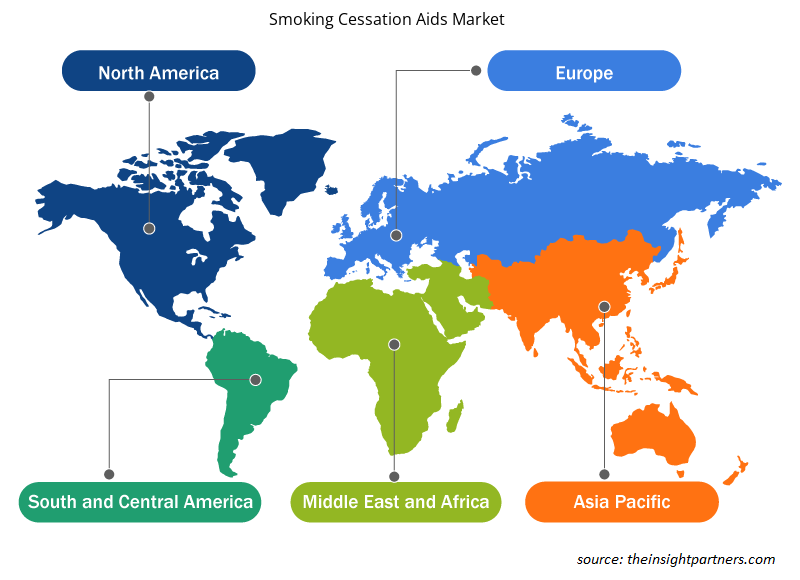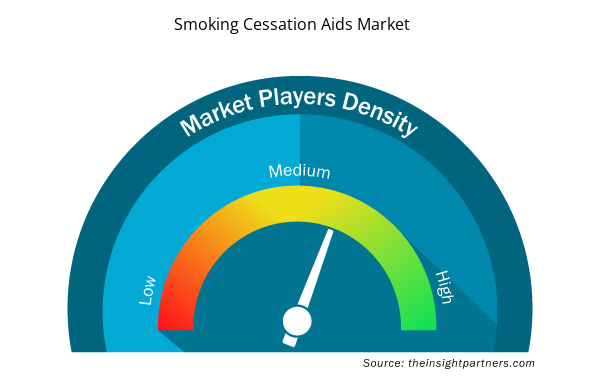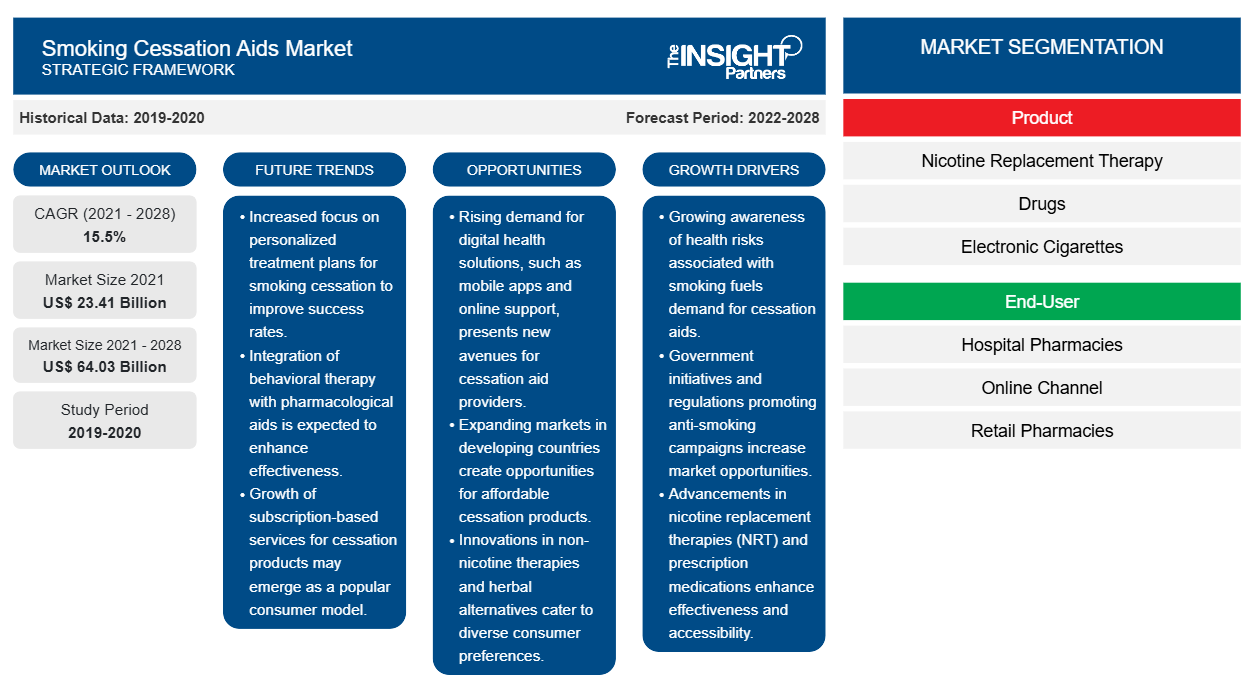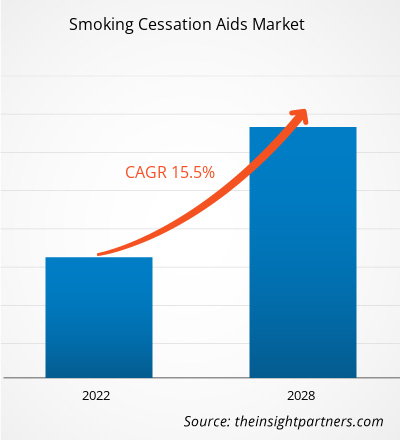Le marché des aides au sevrage tabagique devrait atteindre 64 032,30 millions USD d'ici 2028, contre 23 413,08 millions USD en 2021. Le marché devrait croître à un TCAC de 15,5 % de 2021 à 2028.
Les principaux facteurs qui stimulent la croissance de ce marché des aides au sevrage tabagique sont l'augmentation de la dépendance au tabac et le nombre croissant de campagnes visant à réduire le tabagisme et la dépendance au tabac. Cependant, l'augmentation des coûts de développement des thérapies de substitution à la nicotine est susceptible de freiner dans une certaine mesure la croissance du marché dans les années à venir.
Informations sur le marché
Dépendance croissante au tabagisme
La nicotine est une substance hautement addictive présente dans la plante de tabac. Il est prouvé que fumer du tabac est dangereux sous toutes ses formes car il peut entraîner des problèmes de santé chroniques, des maladies évitables, des décès et des handicaps. Selon l'Organisation mondiale de la santé (OMS), les troubles liés au tabagisme entraînent environ 435 000 décès par an aux États-Unis, ce qui équivaut à environ 1 décès sur 5 dans le pays. Selon les Centers of Disease Control and Prevention (CDC), en 2018, près de 40 millions d'adultes aux États-Unis fumaient des cigarettes. De plus, environ 4,7 millions d'élèves de collège et de lycée ont consommé au moins un produit du tabac et environ 1 600 jeunes de moins de 18 ans aux États-Unis ont fumé leur première cigarette. Chaque année, près d'un demi-million de patients meurent des suites d'une maladie causée par le tabagisme. Le gouvernement américain dépense environ 225 milliards de dollars américains pour les soins médicaux destinés à traiter les patients souffrant de maladies liées au tabagisme aux États-Unis. Par conséquent, la prévalence du tabagisme est élevée dans divers pays du monde.
Personnalisez ce rapport en fonction de vos besoins
Vous bénéficierez d'une personnalisation gratuite de n'importe quel rapport, y compris de certaines parties de ce rapport, d'une analyse au niveau des pays, d'un pack de données Excel, ainsi que de superbes offres et réductions pour les start-ups et les universités.
- Obtenez les principales tendances clés du marché de ce rapport.Cet échantillon GRATUIT comprendra une analyse de données, allant des tendances du marché aux estimations et prévisions.
Le scénario est similaire dans divers pays européens et asiatiques. La Grèce, la Bulgarie, la France et la Croatie comptent parmi les populations les plus consommatrices de tabac en Europe. Selon l’Institute of Health Metrics and Evaluation, le tabagisme est une addiction très courante en Europe puisque plus de 20 % des adultes de plus de 15 ans fument chaque jour. En outre, selon le World Population Review, les taux de tabagisme les plus élevés se trouvent en Asie du Sud-Est et dans les Balkans en Europe. Le WPR suggère également que dans divers pays d’Asie du Sud et du Sud-Est, les taux de tabagisme ont tendance à être élevés chez les hommes. Par exemple, en Indonésie, le taux de tabagisme chez les hommes était de 76,20 % en 2018. Ainsi, le nombre croissant de fumeurs dans le monde stimule la croissance du marché mondial des aides au sevrage tabagique.WPR also suggests that in various South and Southeast Asian countries, the smoking rates tend to be high among men. For instance, in Indonesia, the smoking rate among males was 76.20% in 2018. Thus, the rising number of smoking populations across the world drives the growth of the global smoking cessation aids market.
Informations basées sur les produits
En fonction du produit, le marché des aides au sevrage tabagique est segmenté en thérapie de remplacement de la nicotine, médicaments, cigarettes électroniques et autres. Les cigarettes électroniques sont considérées comme une alternative saine aux cigarettes de tabac et devraient être le segment qui connaît la croissance la plus rapide au cours de la période de prévision. Les cigarettes électroniques sont une alternative efficace pour réduire les problèmes de santé associés au tabac, tandis que les thérapies de remplacement de la nicotine fonctionnent mieux pour arrêter de fumer. Les cigarettes électroniques sont une menace potentielle pour les cigarettes à base de tabac. De plus, la consommation de cigarettes électroniques est moins nocive que les cigarettes ordinaires, aucune fumée et aucun risque de tabagisme passif, autorisée à utiliser même dans les lieux non-fumeurs, des niveaux de nicotine variables et la disponibilité dans diverses saveurs sont quelques-uns des principaux facteurs moteurs du marché des cigarettes électroniques. En outre, la popularité croissante des cigarettes électroniques soutenue par sa fonction électronique est le principal facteur contribuant à sa demande croissante.
Informations basées sur l'utilisateur final
En fonction de l'utilisateur final, le marché des aides au sevrage tabagique est segmenté en pharmacies hospitalières, canaux en ligne, pharmacies de détail et autres utilisateurs finaux. Le segment des pharmacies de détail devrait détenir la plus grande part du marché en 2021, mais le segment des canaux en ligne devrait enregistrer le TCAC le plus élevé du marché au cours de la période de prévision.
Les principaux acteurs tels que Pfizer Inc. ; GlaxoSmithKline plc. ; Dr. Reddy's Laboratories ; Johnson and Johnson Services, Inc. ; Cipla Inc. ; Perrigo Company plc ; Bausch Health Companies Inc. ; Glenmark ; NJOY ; et Juul Labs adoptent plusieurs stratégies organiques et inorganiques pour améliorer leurs revenus et leur position sur le marché. Par exemple, en juillet 2020, Dr Reddy's Laboratories a lancé des pastilles de nicotine Polacrilex en vente libre sur le marché américain dans les dosages de 2 mg et 4 mg. De plus, en novembre 2020, Perrigo Company plc a achevé la quatrième année de sa campagne « Arrêter de fumer, c'est mieux » en partenariat avec l'American Cancer Society (ACS).
Aperçu régional du marché des aides au sevrage tabagique
Les tendances et facteurs régionaux influençant le marché des aides au sevrage tabagique tout au long de la période de prévision ont été expliqués en détail par les analystes d’Insight Partners. Cette section traite également des segments et de la géographie du marché des aides au sevrage tabagique en Amérique du Nord, en Europe, en Asie-Pacifique, au Moyen-Orient et en Afrique, ainsi qu’en Amérique du Sud et en Amérique centrale.

- Obtenez les données régionales spécifiques au marché des aides au sevrage tabagique
Portée du rapport sur le marché des aides au sevrage tabagique
| Attribut de rapport | Détails |
|---|---|
| Taille du marché en 2021 | 23,41 milliards de dollars américains |
| Taille du marché d'ici 2028 | 64,03 milliards de dollars américains |
| Taux de croissance annuel moyen mondial (2021-2028) | 15,5% |
| Données historiques | 2019-2020 |
| Période de prévision | 2022-2028 |
| Segments couverts | Par produit
|
| Régions et pays couverts | Amérique du Nord
|
| Leaders du marché et profils d'entreprises clés |
|
Densité des acteurs du marché des aides au sevrage tabagique : comprendre son impact sur la dynamique des entreprises
Le marché des aides au sevrage tabagique connaît une croissance rapide, tirée par la demande croissante des utilisateurs finaux en raison de facteurs tels que l'évolution des préférences des consommateurs, les avancées technologiques et une plus grande sensibilisation aux avantages du produit. À mesure que la demande augmente, les entreprises élargissent leurs offres, innovent pour répondre aux besoins des consommateurs et capitalisent sur les tendances émergentes, ce qui alimente davantage la croissance du marché.
La densité des acteurs du marché fait référence à la répartition des entreprises ou des sociétés opérant sur un marché ou un secteur particulier. Elle indique le nombre de concurrents (acteurs du marché) présents sur un marché donné par rapport à sa taille ou à sa valeur marchande totale.
Les principales entreprises opérant sur le marché des aides au sevrage tabagique sont :
- Pfizer Inc.
- GlaxoSmithKline plc.
- Laboratoires du Dr Reddy
- Johnson et Johnson Services, Inc.
- Cipla Inc.
Avis de non-responsabilité : les sociétés répertoriées ci-dessus ne sont pas classées dans un ordre particulier.

- Obtenez un aperçu des principaux acteurs du marché des aides au sevrage tabagique
Marché des aides au sevrage tabagique – par produit
- Thérapie de remplacement de la nicotine
- Médicaments
- Cigarettes électroniques
- Autres
Marché des aides au sevrage tabagique – par utilisateur final
- Pharmacies hospitalières
- Chaîne en ligne
- Pharmacies de détail
- Autres
Marché des aides au sevrage tabagique – par géographie
Amérique du Nord
- NOUS
- Canada
- Mexique
Europe
- France
- Allemagne
- Italie
- ROYAUME-UNI
- Espagne
- Reste de l'Europe
Asie-Pacifique (APAC)
- Chine
- Inde
- Japon
- Australie
- Corée du Sud
- Reste de l'Asie-Pacifique
Moyen-Orient et Afrique (MEA)
- Afrique du Sud
- Arabie Saoudite
- Émirats arabes unis
- Reste du Moyen-Orient et de l'Afrique
Amérique du Sud et Amérique centrale (SCAM)
- Brésil
- Argentine
- Reste de l'Amérique du Sud et de l'Amérique centrale
Profils d'entreprise
- Pfizer Inc.
- GlaxoSmithKline plc.
- Laboratoires du Dr Reddy
- Johnson et Johnson Services, Inc.
- Cipla Inc.
- Société Perrigo plc
- Les entreprises Bausch Health Inc.
- Glenmark
- JOYE
- Laboratoires Juul
- Analyse historique (2 ans), année de base, prévision (7 ans) avec TCAC
- Analyse PEST et SWO
- Taille du marché Valeur / Volume - Mondial, Régional, Pays
- Industrie et paysage concurrentiel
- Ensemble de données Excel



Report Coverage
Revenue forecast, Company Analysis, Industry landscape, Growth factors, and Trends

Segment Covered
This text is related
to segments covered.

Regional Scope
North America, Europe, Asia Pacific, Middle East & Africa, South & Central America

Country Scope
This text is related
to country scope.
Questions fréquemment posées
The Smoking Cessation Aids Market majorly consists of the players such as Pfizer Inc., GlaxoSmithKline plc., Dr. Reddy's Laboratories, Johnson and Johnson Services, Inc., Cipla Inc., Perrigo Company plc, Bausch Health Companies Inc., Glenmark, NJOY, Juul Labs among others amongst others.
The US is the largest market for Smoking Cessation Aids at a global level. The market's growth is attributed to the Increasing implementation of various tobacco control programs, high expenditure in healthcare and wellness by the countries in the region and launch of new and innovative products by market players for smoking cessation are some of the factors likely to drive the Smoking Cessation Aids market in the region. According to CDC, in 2017, 14 of every 100 US adults aged 18 years or older (14.0%) currently smoke cigarettes. This hints at a high usage of de-addiction products. Also, this depicts the growing awareness of the people and their readiness to quit smoking. There are also non-government and government establishments working to educate and help people quit smoking that is engaged dedicatedly, to bring the number of smokers down.
Asia Pacific is expected to be the fastest-growing region and is likely to expand at a high growth rate due to increasing awareness about the smoking cessation and nicotine de-addiction products, and a huge population base in the region. For instance, an international collaboration of researchers, led by those from Vanderbilt University in the United States, studied the trends in tobacco use in China, Japan, South Korea, Singapore, Taiwan, and India in Tobacco Smoking and Mortality in Asia, a pooled meta-analysis published by JAMA Network in March 2019. By 2030, it is anticipated that 8.3 million fatalities would be due to smoking. China, India, and Indonesia account for half of the world's male smokers, and Asia is the world's largest tobacco user and production.
The global Smoking Cessation Aids market based on product is segmented into nicotine replacement therapy, drugs, electronic cigarettes, and others. In 2021, the electronic cigarettes segment held the largest share of the market, by product. The electronic cigarettes segment of Smoking Cessation Aids Market is also expected to witness fastest CAGR during 2021 to 2028.The increasing number of campaigns to reduce smoking and tobacco dependence are likely to increase the demand for the above-mentioned products. Therefore, it is expected that market is likely to propel during the forecast period.
The factors that are driving and restraining factors that will affect Smoking Cessation Aids Market in the coming years. Factors such as rising addiction toward tobacco smoking, increasing number of campaigns to reduce smoking and tobacco dependence. However, steeping costs for development of nicotine replacement therapies are likely to restrain the market growth in the future years to some extent.
Smoking cessation lowers the risk of cancer and other serious health problems. Some products contain nicotine as an active ingredient and others do not. Counseling, behavior therapy, medicines, and nicotine-containing products, such as nicotine patches, gum, lozenges, inhalers, and nasal sprays, may be used to help a person quit smoking.
Trends and growth analysis reports related to Life Sciences : READ MORE..
The List of Companies - Smoking Cessation Aids Market
- Pfizer Inc.
- GlaxoSmithKline plc.
- Dr. Reddy's Laboratories
- Johnson and Johnson Services, Inc.
- Cipla Inc.
- Perrigo Company plc
- Bausch Health Companies Inc.
- Glenmark
- NJOY
- Juul Labs
The Insight Partners performs research in 4 major stages: Data Collection & Secondary Research, Primary Research, Data Analysis and Data Triangulation & Final Review.
- Data Collection and Secondary Research:
As a market research and consulting firm operating from a decade, we have published and advised several client across the globe. First step for any study will start with an assessment of currently available data and insights from existing reports. Further, historical and current market information is collected from Investor Presentations, Annual Reports, SEC Filings, etc., and other information related to company’s performance and market positioning are gathered from Paid Databases (Factiva, Hoovers, and Reuters) and various other publications available in public domain.
Several associations trade associates, technical forums, institutes, societies and organization are accessed to gain technical as well as market related insights through their publications such as research papers, blogs and press releases related to the studies are referred to get cues about the market. Further, white papers, journals, magazines, and other news articles published in last 3 years are scrutinized and analyzed to understand the current market trends.
- Primary Research:
The primarily interview analysis comprise of data obtained from industry participants interview and answers to survey questions gathered by in-house primary team.
For primary research, interviews are conducted with industry experts/CEOs/Marketing Managers/VPs/Subject Matter Experts from both demand and supply side to get a 360-degree view of the market. The primary team conducts several interviews based on the complexity of the markets to understand the various market trends and dynamics which makes research more credible and precise.
A typical research interview fulfils the following functions:
- Provides first-hand information on the market size, market trends, growth trends, competitive landscape, and outlook
- Validates and strengthens in-house secondary research findings
- Develops the analysis team’s expertise and market understanding
Primary research involves email interactions and telephone interviews for each market, category, segment, and sub-segment across geographies. The participants who typically take part in such a process include, but are not limited to:
- Industry participants: VPs, business development managers, market intelligence managers and national sales managers
- Outside experts: Valuation experts, research analysts and key opinion leaders specializing in the electronics and semiconductor industry.
Below is the breakup of our primary respondents by company, designation, and region:

Once we receive the confirmation from primary research sources or primary respondents, we finalize the base year market estimation and forecast the data as per the macroeconomic and microeconomic factors assessed during data collection.
- Data Analysis:
Once data is validated through both secondary as well as primary respondents, we finalize the market estimations by hypothesis formulation and factor analysis at regional and country level.
- Macro-Economic Factor Analysis:
We analyse macroeconomic indicators such the gross domestic product (GDP), increase in the demand for goods and services across industries, technological advancement, regional economic growth, governmental policies, the influence of COVID-19, PEST analysis, and other aspects. This analysis aids in setting benchmarks for various nations/regions and approximating market splits. Additionally, the general trend of the aforementioned components aid in determining the market's development possibilities.
- Country Level Data:
Various factors that are especially aligned to the country are taken into account to determine the market size for a certain area and country, including the presence of vendors, such as headquarters and offices, the country's GDP, demand patterns, and industry growth. To comprehend the market dynamics for the nation, a number of growth variables, inhibitors, application areas, and current market trends are researched. The aforementioned elements aid in determining the country's overall market's growth potential.
- Company Profile:
The “Table of Contents” is formulated by listing and analyzing more than 25 - 30 companies operating in the market ecosystem across geographies. However, we profile only 10 companies as a standard practice in our syndicate reports. These 10 companies comprise leading, emerging, and regional players. Nonetheless, our analysis is not restricted to the 10 listed companies, we also analyze other companies present in the market to develop a holistic view and understand the prevailing trends. The “Company Profiles” section in the report covers key facts, business description, products & services, financial information, SWOT analysis, and key developments. The financial information presented is extracted from the annual reports and official documents of the publicly listed companies. Upon collecting the information for the sections of respective companies, we verify them via various primary sources and then compile the data in respective company profiles. The company level information helps us in deriving the base number as well as in forecasting the market size.
- Developing Base Number:
Aggregation of sales statistics (2020-2022) and macro-economic factor, and other secondary and primary research insights are utilized to arrive at base number and related market shares for 2022. The data gaps are identified in this step and relevant market data is analyzed, collected from paid primary interviews or databases. On finalizing the base year market size, forecasts are developed on the basis of macro-economic, industry and market growth factors and company level analysis.
- Data Triangulation and Final Review:
The market findings and base year market size calculations are validated from supply as well as demand side. Demand side validations are based on macro-economic factor analysis and benchmarks for respective regions and countries. In case of supply side validations, revenues of major companies are estimated (in case not available) based on industry benchmark, approximate number of employees, product portfolio, and primary interviews revenues are gathered. Further revenue from target product/service segment is assessed to avoid overshooting of market statistics. In case of heavy deviations between supply and demand side values, all thes steps are repeated to achieve synchronization.
We follow an iterative model, wherein we share our research findings with Subject Matter Experts (SME’s) and Key Opinion Leaders (KOLs) until consensus view of the market is not formulated – this model negates any drastic deviation in the opinions of experts. Only validated and universally acceptable research findings are quoted in our reports.
We have important check points that we use to validate our research findings – which we call – data triangulation, where we validate the information, we generate from secondary sources with primary interviews and then we re-validate with our internal data bases and Subject matter experts. This comprehensive model enables us to deliver high quality, reliable data in shortest possible time.


 Obtenez un échantillon gratuit pour ce rapport
Obtenez un échantillon gratuit pour ce rapport